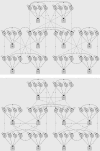Reconsidering the heritability of intelligence in adulthood: taking assortative mating and cultural transmission into account
- PMID: 21969232
- PMCID: PMC3276760
- DOI: 10.1007/s10519-011-9507-9
Reconsidering the heritability of intelligence in adulthood: taking assortative mating and cultural transmission into account
Abstract
Heritability estimates of general intelligence in adulthood generally range from 75 to 85%, with all heritability due to additive genetic influences, while genetic dominance and shared environmental factors are absent, or too small to be detected. These estimates are derived from studies based on the classical twin design and are based on the assumption of random mating. Yet, considerable positive assortative mating has been reported for general intelligence. Unmodeled assortative mating may lead to biased estimates of the relative magnitude of genetic and environmental factors. To investigate the effects of assortative mating on the estimates of the variance components of intelligence, we employed an extended twin-family design. Psychometric IQ data were available for adult monozygotic and dizygotic twins, their siblings, the partners of the twins and siblings, and either the parents or the adult offspring of the twins and siblings (N = 1314). Two underlying processes of assortment were considered: phenotypic assortment and social homogamy. The phenotypic assortment model was slightly preferred over the social homogamy model, suggesting that assortment for intelligence is mostly due to a selection of mates on similarity in intelligence. Under the preferred phenotypic assortment model, the variance of intelligence in adulthood was not only due to non-shared environmental (18%) and additive genetic factors (44%) but also to non-additive genetic factors (27%) and phenotypic assortment (11%).This non-additive nature of genetic influences on intelligence needs to be accommodated in future GWAS studies for intelligence.
Figures



References
Publication types
MeSH terms
LinkOut - more resources
Full Text Sources

